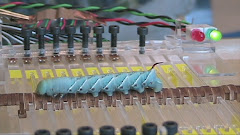The earliest documented rotary locomotion I could find was from this shrimp like creature living on sandy beaches. It has short legs specialized for swimming. So when there is no water, they flip on their backs and performed a slow body rolling motion (Caldwell 1979).
 Of course, a much more dynamic gymnast has to be this somersaulting spider in Sahara desert. This little guy can perform amazing somersaults across the dessert sand after a running start up to 2 m/s, according to the discoverer Dr. Ingo Rechenberg. Check out some of his videos on YouTube: Short intro; Extended
Of course, a much more dynamic gymnast has to be this somersaulting spider in Sahara desert. This little guy can perform amazing somersaults across the dessert sand after a running start up to 2 m/s, according to the discoverer Dr. Ingo Rechenberg. Check out some of his videos on YouTube: Short intro; Extended Despite the amazing gymnastic moves, the above two creatures don't really roll in a circular form. The stomatopod really just flips its body by reaching the head with the tail, and the somersaulting spider actually got airborne in their strides. A true wheel is one that relies on the continuous contact of same radius spokes. The following two examples are animals that form quite perfect circles for downhill passive rolling. They are really very cute and circular... (Henschel 1990, 1995; Garcia-Paris et al 1995)
Despite the amazing gymnastic moves, the above two creatures don't really roll in a circular form. The stomatopod really just flips its body by reaching the head with the tail, and the somersaulting spider actually got airborne in their strides. A true wheel is one that relies on the continuous contact of same radius spokes. The following two examples are animals that form quite perfect circles for downhill passive rolling. They are really very cute and circular... (Henschel 1990, 1995; Garcia-Paris et al 1995)
 Finally, the true powered wheeler is still my favorite rolling mother-of-pearl caterpillar. These caterpillars would curl into a wheel ballistically and catapult themselves into free-wheeling objects when disturbed (Bruckenbury 1997, 1999). According to the scientist who characterized this motion Dr. John Bruckenbury, there are a few more species of caterpillars that perform this behavior. It's really quite an effective way to escape. [pictures below are from Bruckenbury 1997 publication]
Finally, the true powered wheeler is still my favorite rolling mother-of-pearl caterpillar. These caterpillars would curl into a wheel ballistically and catapult themselves into free-wheeling objects when disturbed (Bruckenbury 1997, 1999). According to the scientist who characterized this motion Dr. John Bruckenbury, there are a few more species of caterpillars that perform this behavior. It's really quite an effective way to escape. [pictures below are from Bruckenbury 1997 publication]
Armour, R. H. and Vincent, J. F. V. (2006). Rolling in Nature and Robotics: A Review. Journal of Bionic Engineering 3, 195-208.
Brackenbury, J. (1997). Caterpillar Kinematics. Nature 390, 453.
Brackenbury, J. (1999). Fast Locomotion in Caterpillars. J. Insect Physiol. 45, 525-533.
Deban, S. M. (1995). A Novel Antipredator Mechanism in Salamanders: Rolling Escape in Hydromantes Platycephalus. J. Herpetol. 29, 149-151.
Full, R., Earls, K., Wong, M. and Caldwell, R. (1993). Locomotion Like a Wheel? Nature 365, 494.
Gould, S. J. (1981). Kingdoms without Wheels. Natural History 90, 42-48.
LaBarbera, M. (1983). Why the Wheels Won't Go. Am. Nat. 121, 395-408.
Siegwart, R., Lamon, P., Estier, T., Lauria, M. and Piguet, R. (2002). Innovative Design for Wheeled Locomotion in Rough Terrain. Robotics and Autonomous systems 40, 151-162.

.jpg)
Very useful info!
ReplyDeleteThanks!